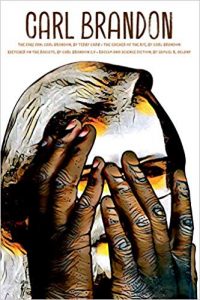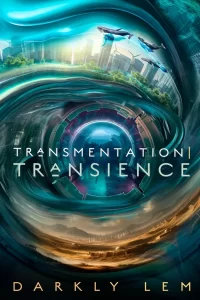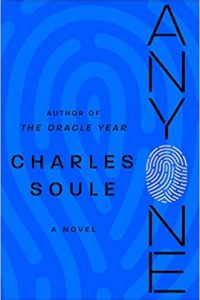Katharine Coldiron Reviews Carl Brandon, Edited by Jeanne Gomoll
 Carl Brandon, Jeanne Gomoll, ed. (Union Street Press 978-0-35957-906-8, $16.00, 92pp, tp) June 2019.
Carl Brandon, Jeanne Gomoll, ed. (Union Street Press 978-0-35957-906-8, $16.00, 92pp, tp) June 2019.
There’s a lot going on in the little book called Carl Brandon, a self-published volume edited by Jeanne Gomoll. It collects five texts by various authors: an introduction by Nisi Shawl & K. Tempest Bradford, who co-founded the Carl Brandon Society; an explanatory essay by Terry Carr, who co-founded Carl Brandon himself; “The Cacher of the Rye”, a satirical short story by Brandon, AKA Terry Carr; “Kvetcher on the Racists”, an even shorter satire by Carl Brandon 2.0, AKA Nisi Shawl; and “Racism and Science Fiction”, an essay by Samuel R. Delany. These texts, together, explain what the hell “Carl Brandon” signifies: not a person, but a collection of ideas. It’s not the ideas but their context that renders the book fascinating.
Carl Brandon purports to be about race and science fiction, but for someone unfamiliar with mid-20th-century science fiction fandom, it is also an education about how immersive and specific fandom was in that era. Terry Carr explains in his essay that he and his fellow fans built and maintained an entire ecosystem of writing and social activity that fed on and occasionally crossed over into professional science fiction publishing. The purpose of this realm can only be guessed at from the texts in Carl Brandon, but it seems to have been entirely created to discuss and satirize pro SF writings and writers, both to take them seriously (more so than the larger literary discourse did at the time) and to send them up.
When I say “ecosystem,” imagine Tumblr. Imagine the specific kinds of rhetoric and protocol that have been nurtured into existence there, the way in which people who focus their social or even intellectual lives around Tumblr often communicate in language obscure to their parents, co-workers, children. Imagine the LiveJournal communities of the early 2000s, or, more darkly, imagine 4chan. That’s the kind of ecosystem I’m referring to: a not-necessarily geographical space loosely folded around affections or obsessions, one which invents and refines its own rules, mores, and language.
Carr’s introduction uses this language to some extent – words and acronyms like “gafiate,” “bheerbust,” or “BNF,” and terms like “fugghead,” a specific insult. But the centerpiece of the book, Brandon’s “The Cacher of the Rye”, uses the language of 1950s fandom to such an extent that some of the text is incomprehensible: “Jane Trafalgar. Ghu damn! She’s a cartoonist… I used to play four dimensional mental crifanac with her all the time.” The story is a short parody of The Catcher in the Rye, replacing Holden Caulfield’s concerns with those of fandom but retaining his voice and the general storyline of Catcher. As such, whether it interests the reader will depend on how delighted the reader is by this kind of parody, and how interested she is in a 70-year-old satirical text originally hand-copied on mimeograph machines and mailed out to the writers’ friends and colleagues for a laugh.
The fact that the language of 1950s fandom was so specific, that this group of young men did all this work to communicate with each other, that the whole community depended for its existence on stories and novels that have mostly vanished in the great paperback graveyard of the 20th century – this context is the most compelling aspect of Carl Brandon. But it’s not the point of the book. That would be to explain the existence of Carl Brandon to readers and writers of this century. As Carl Brandon 2.0 writes in “The Kvetcher on the Racists”, “I’m imaginary. I’m a hoax. I’m the product of a bunch of fannish brains. As you’ll read elsewhere in this book, I was outed maybe 70 years ago.” Carr and a few other fans in the San Francisco Bay Area invented Brandon as a pseudonym for work that appeared in fanzines like Lingam, Innuendo, Cry of the Nameless, and many others. Hoaxes were plentiful in those days, in that community, but Brandon was a pretty significant one.
He just happened to be black. All of Brandon’s creators were white, but they noted that black people seemed poorly represented in science fiction fandom. They decided to try and turn that around with a fictional personality who already had some popularity as a writer: “We had recently put Carl on the FAPA waiting list, and though none of us had dreamed that he might be black, who was to say that he wasn’t? What a marvelous opportunity to put fandom’s sometimes self-congratulatory openmindedness to the test!” The book does not tackle whether it’s proper for a bunch of white men to have invented this black man as a social experiment, but I’m not sure it matters; the effect seems to have been wholly positive, judging from Brandon’s legacy. The society in his name awards cash prizes to diverse genre writers. This book seems quite jolly about his existence, and determined to use his name to smoke out racists and promote writers of color among the sci-fi community.
Carl Brandon closes with Samuel R. Delany’s exceptionally articulate essay about race in genre fiction, previously published in The New York Review of Science Fiction. He discloses some of his own experiences and then broadens them to explore systematic aspects of racism:
As [a system], it is fueled as much by chance as by hostile intentions and equally the best intentions as well. It is whatever systematically acclimates people, of all colors, to become comfortable with the isolation and segregation of the races, on a visual, social, or economic level.
Carl Brandon‘s editor plainly has a point to make with regard to race in publishing this book. However, the race aspect of Carl Brandon’s existence turned out to be almost incidental to this reviewer in light of the strange, fecund ecosystem from whence he sprung – much as it was to his creators. Delany’s and Shawl’s work in this volume is exceedingly worthy, even necessary, but for readers in the 2010s, 1950s fandom may prove even more irresistible.
Katharine Coldiron is the author of Ceremonials (Kernpunkt Press), an SPD fiction bestseller. Her work as a book critic has appeared in The Washington Post, The Believer, The Guardian, and many other places. She lives in California and at kcoldiron.com.
This review and more like it in the January 2020 issue of Locus.
 While you are here, please take a moment to support Locus with a one-time or recurring donation. We rely on reader donations to keep the magazine and site going, and would like to keep the site paywall free, but WE NEED YOUR FINANCIAL SUPPORT to continue quality coverage of the science fiction and fantasy field.
While you are here, please take a moment to support Locus with a one-time or recurring donation. We rely on reader donations to keep the magazine and site going, and would like to keep the site paywall free, but WE NEED YOUR FINANCIAL SUPPORT to continue quality coverage of the science fiction and fantasy field.







